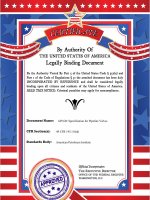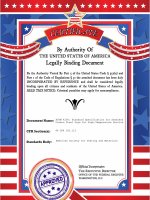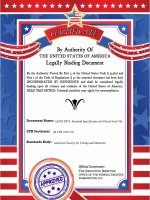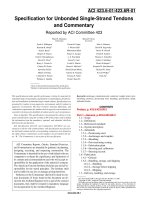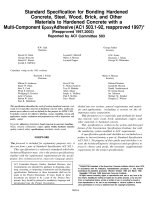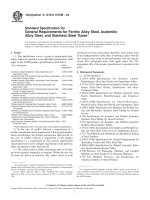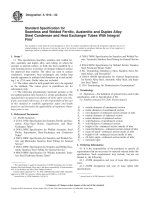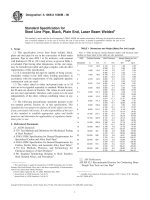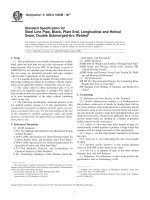ASTM D52-62 (1981) Specification for Wood Paving Blocks for Exposed Platforms, Pavements, Driveways, and Interior Floors Exposed to Wet and Dry Conditions
Bạn đang xem bản rút gọn của tài liệu. Xem và tải ngay bản đầy đủ của tài liệu tại đây (154.99 KB, 3 trang )
• Designation: D 52 - 62 (Reapproved 1981)
Standard Specification for
WOOD PAVING BLOCKS FOR EXPOSED PLATFORMS,
PAVEMENTS, DRIVEWAYS, AND INTERIOR FLOORS
EXPOSED TO WET AND DRY CONDITIONS1
This standard is issued under the fixed designation D 52: the number immediately following the designation indicates the year of
original adoption or. in the case of revision. the year of last revision. A number in parentheses indicates the year of last reapproval.
A superscript epsilon(<) indicates an editorial change since the last revision or reapproval.
l. Scope 4. Size of Blocks
1.1 This specification covers creosoted end 4.1 The blocks shall be from 5 to 8 in. (127
grain wood paving blocks for exposed plat- to 203.2 mm) in length, but the length shall not
forms, pavements, and other areas exposed to exceed three times the depth; they shall be 2 to
alternately wet and dry conditions. The speci- 4 in. (50 to 101.6 mm) in depth parallel to
fication is divided into two parts, one covering grain. They may be 2Y2 to 4 in. (63 to 101.6
material and the other a recommended practice mm) in width, but on any one area all shall be
for installation. of uniform width. Permissible variations from
the specified dimensions shall not exceed VIs in.
PART I-MATERIAL (I mm) in depth and Ys in. (3 mm) in width. In
all cases the width shall be greater or less than
2. Species of Timber the depth by at least \-4 in. (6 mm).
2.1 The wood, which shall be treated, shall 5. Preservative
be southern pine, Douglas fir, oak, gum, or
other species mutually agreed upon by the pur- 5.1 The preservative used shall be either
chaser and the seller. Only one kind of wood creosote furnished in accordance with ASTM
shall be used in any one contract. Specification D 390, Coal-Tar Creosote for the
Preservative Treatment of Piles, Poles, and
J .. Quality of Timber Timbers for Marine, Land and Fresh Water
Use,2 or creosote coal-tar solution furnished in
3.1 The blocks shall be sound and well man- accordance with ASTM Specification D 391,
ufactured, square butted and square edged, and Creosote-Coal Tar Solution.2
shall be free from unsound loose or hollow
knots, knot holes, and other defects such as 6. Preservative Treatment
shakes, checks, etc., that would be detrimental
to the blocks. 6.1 The timber may be green or partially air-
seasoned with moisture co~ent not less than 30
3.2 Blocks manufactured of southern pine or percent and treated with not less than 10 Ib of
creosote oil per cubic foot of timber by a stand-
Douglas frr shall average not less than four ard pressure process, with thorough diffusion
atmU'al rin~ per inch measured O\f.Cf the third, throughout the sapwood.
fourth, and fifth inches from the pith. In blocks 1 This specification is under the jurisdiction of ASTM Com-
not containing the pith, measurement shall be mittee 0-7 on Wood.
made on a 3-in. (76-mm) radial line over a
portion of the cross section that is representa- Current edition effective Sept. 28. 1962. Originally issued
.tive of the average growth. No block shall have 1918. Replaces D 52-59 T.
less than three rings per inch measured as
above, and not more than 5 percent of the 2 Annual Book ofASTM Standards. Vol 04.09.
pieces in any lot may have three rings per inch.
30
7. Retention of Preservative 052
7.1 The net retention in any charge shall be the blocks therefrom shall be subject to inspec-
not less than 90 percent of the quantity of tion, acceptance, or rejection at the plant of the
preservative that may be specified. The average manufacturer, which shall be equipped with all
retention by the wood blocks treated under any the necessary gages, appliances, and. facilities
contract or order of five charges or more, and to enable the inspector to satisfy himself that
the average retention of any five consecutive the requirements of the specification are being
charges shall be not less than 100 percent of the fulfilled.
quantity specified, except when the character
of the wood in any charge makes these require- PART II-RECOMMENDED PRACTICE FOR
ments impracticable, despite treatment to re- INSTALLATION
fusal. In the latter case, allowance shall be
made for the difference between the quantities 10. Foundation
of preservative specified and retained. When
the contract or order comprises less than five 10.1 The concrete foundation shall be fin-
charges, the average retention shall be not less ished to a smooth even surface, exactly the
than 95 percent of the quantity specified. The depth below the fmished level corresponding to
amount of preservative retained shall be cal- the depth of the block to be used and with
culated from readings of working-tank gages or sufficient crown to quickly drain off all water
scales, or from weights before and after treat- from the surface. Care must be taken to see
ment of loaded trams on suitable track scales that there are no projections or waves in the
with the necessary corrections for changes in concrete that will form an uneven bearing for
moisture content. the blocks.
7.2 The amount of preservative retained by 11. Bituminous Paint Coat
~e blocks shall be as stipulated in purchase
t_order and in no case shall be less than 10 lb/ft3 ll.l On the thoroughly cleaned and dried
'of wood in the charge. concrete base shall be spread a thin uniform
coat of hot coal-tar pitch conforming to the
7.3 The volume of preservative shall be cal- requirements specified in Table l. It shall be
heated to a temperature of not less than 250 F,
lculated on the basis of a temperature of 100 F. (121 C) and not more than 300 F, (149 C) and
squeegeed or sprayed over the concrete while
Calculations of volume or weight shall be made hot in a thin, uniform coating Y1B to Ys in. ( l to
by the use of temperature or specific gravity 3 mm) in thickness.
! factors contained in ASTM D 347, Volume and
· Specific Gravity Correction Tables for Creo- 12. Laying Blocks
sote and Coal Tar.2
12.1 The blocks shall be laid on the
8. Penetration of Preservative hardened bituminous paint coat with the grain
of the wood vertical, in straight parallel lines
8.1 The blocks after treatment shall show without ramming, leaving enough space be-
satisfactory penetration of the preservative, and tween the blocks to afford expansion. All joints
in all cases the oil shall be distributed through- shall be broken by a lap of at least 1 in. (25
out the sapwood. To determine this, at least 25 mm). No less than half blocks shall be used
blocks shall be selected from various parts of except for closures.
each charge and sawed in half perpendicular to
the fibers through the center, and if more than 12.2 Against walls, curbs, or other obstruc-
one of these blocks show untreated sapwood, tions, a bituminous expansion joint at least I
in. (25 mm) in width shall be installed. It may
!the charge shall be retreated. After retreating, be either a premoulded or a poured joint, using
the same bitumen used as a filler.
the charge shall be again subjected to a similar
inspection and rejected if all blocks do not 12.3 After the floor has been cut in, two
show complete sapwood penetration. coats of bituminous binder shall be applied at
the highest possible temperature without burn-
~· Inspection at Plant ing or injuring its consistency, by the use of a
squeegee machine. Care must be exercised to
9.1 All material prescribed in this specifica- work the binder into the joints uniformly and
tion and processes used in the manufacture of
31
in such a manner as to leave a minimum of this 052
binder on the surface. The light film of bitumen
on the surface will wear off readily under Bituminous Materials.3
traffic. 13.1.3 Softening Point-ASTM Method
13. Methods of Sampling and Testing D 61, Test for Softening Point of Pitches (Cube-
in-Water Method).4
13.1 The coat-tar pitch shall be sampled and
the properties as enumerated in this specifica- 13.1.4 Bitumen Soluble in Carbon Disuljide-
tion shall be determined in accordance with the ASTM Method D 4, Test for Bitumen.4
following methods:
13.1.5 Distillation-ASTM Method D 20,
13.1.1 Sampling-ASTM Methods D 140, Test for Distillation of Road Tars.3
Sampling Bituminous Materials.3
13.1.6 Specific Gravity of Distillate-ASTM
13.1.2 Specific Gravity--ASTM Method Method D 369, Test for Specific Gravity ofCreo-
D 70, Test for Specific Gravity of Semi-Solid sote Fractions and Residues.2
3 Annual Book ofASTM Standards, Vol 04.03.
4 Annual Book ofASTM Standards, Vol 04.04.
TABLE 1 Requirements for Coal-Tar Pitch
(Homogeneous)
Min Max
Specific gravity, 25/25 C (77/77 F) 1.22 1.34
Softening point (cube-in-water 135 F
(57 C) 155 F
method) 72 (68C)
Total bitumen soluble in carbon di-
1.03 85
sulfide, percent
Distillation: 10
total distillate by weight, 32 to
572 F (0 to 300 C), percent
Specific gravity, 100/60 F (38/
15.5 C) oftotal distillate to 572 F
(300 C)
The American Society for Testing and Materials takes no position respecting the validity of any patent rights asserted in
connection with any item mentioned in this standard. Users ofthis standard are expressly advised that determination ofthe validity
of any such patent rights, and the risk of infringement of such rights, are entirely their own responsibility.
This standard is subject to revision at any time by the responsible technical committee and must be reviewed everyfive years
and if not revised, either reapproved or withdrawn. Your comments are invited eitherfor revision ofthis standard orfor additional
standards and should be addressed to ASTM Headquarters. Your comments will receive careful consideration at a meeting of the
responsible technical committee, which you may attend. Ifyoufee/that your comments have not received a fair hearingyou should
make your views known to the ASTM Committee on Standards, 1916 Race St., Philadelphia, Pa. 19103.
32
